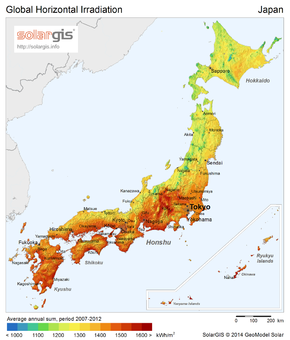
Back الطاقة الشمسية في اليابان Arabic Energía solar en Japón Spanish Énergie solaire au Japon French Tenaga surya di Jepang ID 日本の太陽光発電所 Japanese जपानमधील सौर ऊर्जा Marathi

Solar power in Japan has been expanding since the late 1990s. The country is a major manufacturer and exporter of photovoltaics (PV) and a large installer of domestic PV systems, with most of them grid connected.[1]
Solar power has become an important national priority since the country's shift in policies toward renewable energy after the Fukushima Daiichi nuclear disaster in 2011.[2][3] Japan was the world's second largest market for solar PV growth in 2013 and 2014, adding a record 6.97 GW and 9.74 GW of nominal nameplate capacity, respectively. By the end of 2017, cumulative capacity reached 50 GW, the world's second largest solar PV installed capacity, behind China.[4][5]
In line with the significant rise in installations and capacity, solar power accounted for 9.9% of Japan's national electricity generation in 2022, up from 0.3% in 2010.[6]
- ^ "Cumulative Installed Solar Photovoltaics Capacity in Leading Countries and the World, 2000-2013". Earth Policy Institute. June 18, 2014. Retrieved 2014-09-03.
- ^ "Solar Energy in Japan – Summary". GENI. Retrieved 7 May 2012.
- ^ Chisaki Watanabe (August 26, 2011). "Japan Spurs Solar, Wind Energy With Subsidies, in Shift From Nuclear Power". Bloomberg.
- ^ "Snapshot of Global Photovoltaic Markets 2017" (PDF). report. International Energy Agency. 19 April 2017. Retrieved 27 April 2017.
- ^ Pv-magazine FEBRUARY 15, 2018. "Japan will likely install 6 GW to 7.5 GW (DC) of solar in 2018, from about 7 GW in 2017..."
- ^ "Share of electricity production from solar: Japan". Our World In Data. 2023. Retrieved 2023-12-18.